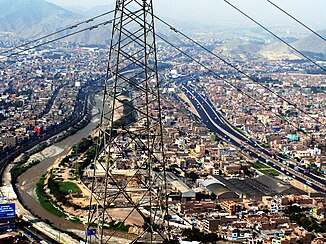Río Rímac
| Río Rímac | ||
|
Río Rímac near Lurigancho |
||
| Data | ||
| location |
|
|
| River system | Río Rímac | |
| Headwaters |
Western Cordillera , 100 km east-northeast of Lima 11 ° 34 ′ 41 ″ S , 76 ° 15 ′ 53 ″ W |
|
| Source height | approx. 4700 m | |
| muzzle | in Callao in the Pacific Coordinates: 12 ° 1 ′ 40 ″ S , 77 ° 9 ′ 2 ″ W 12 ° 1 ′ 40 ″ S , 77 ° 9 ′ 2 ″ W |
|
| Mouth height | 0 m | |
| Height difference | approx. 4700 m | |
| Bottom slope | approx. 36 ‰ | |
| length | approx. 132 km | |
| Catchment area | approx. 3300 km² | |
| Left tributaries | Río Blanco | |
| Right tributaries | Río Santa Eulalia | |
| Big cities | Lima , Callao | |
| Small towns | Matucana | |
|
Río Rímac in Lima |
||
The Río Rímac ( Quechua : Rimaq ) is an approximately 132 km long tributary of the Pacific Ocean in Peru , which irrigates the coastal desert around the capital Lima . Furthermore, the glacier water is the basis for the drinking water supply of the Lima metropolitan area.
Surname
Its name comes from the Quechua language, where rimaq means “speaker” or “oracle”: the indigenous peoples of the region saw a proclamation of divine wisdom in the thunder of the river .
River course
The river has a length of about 204 km, it rises in the western cordillera ( Cordillera Occidental ) of the Andes high mountains at an altitude of about 4700 m . From there it flows in a predominantly west-southwest direction through the mountains. The national road 22 (Lima - La Oroya ) runs along the river. At river kilometer 57 the Río Santa Eulalia flows into the river on the right side. This later flows through the capital Lima and the neighboring coastal city of Callao before flowing into the Pacific Ocean.
The river feeds itself from the glacial melt waters of the western high and mountain ranges. In winter its water flow is low, but in summer it swells - just like its tributaries - to form a torrent.
Use of hydropower
Electricity is generated in several hydropower plants, which supplies Lima with most of the electricity it needs. The hydropower plants along the Río Rímac are Matucana , Moyopampa and Huampaní . Furthermore, the water is diverted to the Callahuanca hydropower station in the river valley of the tributary Río Santa Eulalia.
history
In 1535 , Francisco Pizarro founded the Peruvian capital "Ciudad de los Reyes" (Spanish: "City of Kings"), today's Lima, on the banks of the Río Rímac. Its present name from the Peruvian capital of a different pronunciation of "Rimac" (Limaq): Thus, in Huanca-Quechua today that [r] the other Quechua variants like [ l ] spoken.
literature
- Fiorella Vega-Jácome, Waldo Sven Lavado-Casimiro, Oscar Gustavo Felipe-Obando: Assessing hydrological changes in a regulated river system over the last 90 years in Rimac Basin (Peru) . Theoretical and Applied Climatology, April 2018, Volume 132, Issue 1–2, pp. 347–362
Web links
- Juan Diego Chávez Espinoza: Adaptation to Climate Change in the Rímac River Basin River . BMZ / KfW, December 2010
- M. Montoya, E. Mamani: Origin and residence time of water in the Lima Aquifer . Arxiv, 2014
Individual evidence
- ↑ Juan Diego Chávez Espinoza: Adaptation to Climate Change in the Rímac River Basin River . BMZ / KfW, December 2010, p. 8

